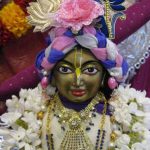Q. While you believe that Srila Prabhupada is in sakhya-rasa, these words from his commentary on Sri Caitanya-caritamrita (Madhya 11.31) indicate to me that he must be in madhurya-rasa.
"There are different types of devotees–those in the santa-rasa (neutrality), dasya-rasa (servitude), sakhya-rasa (friendship), vatsalya-rasa (parental affection), and madhurya-rasa (conjugal love). Although all the rasas are on the transcendental platform, madhurya-rasa is the supreme transcendental mellow. Consequently, it is concluded that the worship of devotees engaged in the Lord's service in madhurya-rasa is the supreme spiritual activity. Sri Caitanya Mahaprabhu and his followers mainly worship Lord Krishna in madhurya-rasa. . . . It is he only who distributed love of Krishna while exhibiting the superexcellence of loving Krishna in the conjugal rasa." Any comments?
A. Madhurya-rasa and manjari-bhava, or Radha-dasyam in particular, is the highest reach of Mahaprabhu's divine dispensation. There is no question about this. Sri Rupa refers to it as tad bhavecchamayi kamanuga bhakti, or bhakti that follows the course of kama by way of attaching itself to the bhava of Radha, as opposed to sambhogecchamayi kamanuga bhakti, in which the devotee seeks a direct conjugal relationship with Krishna and ostensibly may be a competitor of Radha. Because no intimacy with Krishna is greater than that of Radha's, if one seeks the greatest intimacy, one can experience it by way of attaching oneself to her bhava by becoming her handmaiden.
Within raganuga-bhakti, kamanuga (gopi-bhava) is distinguished from sambandhanuga (dasya, sakhya, and vatsalya) in that it is not based on any legitimate relationship (sambandha), such as servitude, friendship, or parental love. In other words, parakiya is illegitimate within the social fabric of the Vraja-lila. However, because it gives the highest pleasure to Krishna, it is the highest form of dharma, samsiddhir hari tosanam–prema dharma in its fullest expression.
This is the Gaudiya conclusion (siddhanta) on this matter, so regardless of an acarya's personal sentiment, he or she will teach this siddhanta, especially when commenting on Caitanya-caritamrita where this subject is central. I also teach this despite my personal attraction to sakhya-rasa. Thus Srila Prabhupada also taught it despite his stated personal affinity for sakhya-rasa. Objective truth is one thing and personal subjective affinity is another. Sometimes we will speak about one and sometimes the other. If we look carefully at the statements of Srila Prabhupada, it is clear when he is speaking about the objective truth of gopi-bhava's position in the lila for the purpose of teaching the siddhanta and when he is speaking subjectively about his own personal affinity. Sri Rupa wrote about all the rasas equally in his book Bhakti-rasamrita-sindhu, but in Ujjvala-nilamani he wrote specifically about his own personal sentiment (madhurya).
Despite the objective superiority of gopi-bhava, the venerable Krishnadasa Kaviraja Goswami makes it clear that the best rasa is the one that is subjectively best for each devotee. The idea is that while we teach that gopi-bhava is the most intimate relationship with Krishna, the best relationship with Krishna is the one each devotee personally cherishes. Thus in the final analysis it can be said that one rasa is not higher than another, even when from a neutral perspective gopi-bhava is the highest.
Let us look for a moment at how a sakhya-rasa bhakta will experience mantra-mayi-upasana in relation to a description of the lila. Mantra-mayi-upasana in mentioned in Bhaktisiddhanta Saraswati Thakura's commentary on Brahma-samhita. It consists of meditating on a still picture of the eternal movie of Krishna-lila represented in one mantra or verse. In the following Bhagavatam verse, the gopis voice their love:
"O friends, those eyes that see the beautiful faces of the sons of Maharaja Nanda are certainly fortunate. As these two sons enter the forest, surrounded by their friends, driving the cows before them, they hold their flutes to their mouths and glance lovingly on the residents of Vrindavana. For those who possess eyes, we think there is no greater object of vision." (SB 10.21.7)
Here the gopis ostensibly glorify the love of the cowherds for Balarama and Krishna, describing the supreme object of vision as the sight of them entering the forest with their friends and cows. How much better is it, then, to be in that picture and enter the forest along with them as cowherds? This is the gopas' great fortune, and this wistful statement by the gopis indicates a certain jealousy toward Krishna's friends, for whom there are no obstacles to spending the entire day with Krishna. This verse thus supports the cowherds' subjective reality, in which they consider fraternal love to be most desirable. A sakhya-rasa bhakta will meditate on this verse and see it as confirmation that his love is the best. Even the gopis say so!
However, Balarama and Krishna together are not the object of love for the gopis headed by Radha. Thus it can be said that from the madhurya vantage point they mention Balarama in this verse only to veil their love for Krishna, which they cannot express as openly as the cowherds can express their love for Krishna. By mentioning Balarama and the cowherds along with Krishna, they dissimulate their conjugal paramour love for Krishna. Furthermore, if a practitioner's heart follows the love of the gopis, this verse will speak to him accordingly and he will have no difficulty making Balarama fade into the background of the verse. As Visvanatha Chakravarti Thakura has explained, those in gopi-bhava will hear the gopis in this verse speaking only of Krishna's face adorned with flute and looking back at them: "Those who give up shyness to drink the nectar of that face playing the flute (Krishna), among the two sons of Nanda herding cows in the forest with their friends, have fortunate senses and not others."
Q. There are some verses in Caitanya-caritamrta (2.8.201-6) that seem to indicate that only a devotee in madhurya-rasa can bestow this rasa on another. Does that mean that if Srila Prabhupada was in sakhya-rasa he could not give his disciples madhurya-rasa?
A. The verses you mentioned do not tell us that only a devotee in madhurya-rasa can bestow madhurya-rasa on another, as some claim. They merely say that in order to enter gopi-bhava one must follow in the footsteps of the gopis. This option is open to all of Prabhupada's disciples. He has given them Harinama, and Nama is cintamani svarupa. He has also given them the Gopala mantra and "gopijana vallabhaya svaha" is available therein among other options. Does Srila Prabhupada not have the power to place one under the care of Sri Rupa at the appropriate stage if one so desires? Where does this idea come from?
It is speculative or worse to dismiss Srila Prabhupada's own stated sentiment as if it were not his eternal affinity and then try to force him into the sentiment one may want him to be in (madhurya-rasa). It only makes matters worse to do so based on the misunderstanding that if Srila Prabhupada were in sakhya-rasa he would be incapable of delivering his disciples who desire gopi bhava to their desired destination. And there are examples of disciples attaining different bhavas from that of their gurus. Syamananda Pandit of course comes to mind. His eternal guru is in sakhya-rasa, whereas he is in madhurya-rasa.
In Srila Prabhupada's case, as in the case of Syamananda's guru Hridaya Caitanya, there is considerable evidence that he had a preference for priya-narma sakhya bhava (see the booklet O My Friend!). Radha-sahasra-nama says that when Radha desires to taste sakhya-rasa, she manifests as Subala, the foremost priya-narma sakha. Note that priya-narma sakhya-rasa has also been labeled sakhi-bhava by Sri Rupa. That is to say that there is a madhurya component in this rasa.
Q. If your diksa guru Srila Prabhupada is in sakhya-rasa and your siksa guru B. R. Sridhara Maharaja is in madhurya-rasa, wouldn't you be obliged to worship the guru who is in madhurya-rasa on a higher level?
A. You ask that if one has a diksa guru in sakhya-rasa and siksa guru in madhurya-rasa, will the madhurya-rasa guru be given more respect because madhurya-rasa is higher than sakhya-rasa? The answer is that both will be given equal respect. All considered, the most important guru is the one who is helping us the most at a particular point in time. Therefore we should be careful not to allow mundane conceptions of lower and higher to enter our minds in such matters. My gurus love Krishna perfectly, although differently in terms of details, and my ideal is to do the same by their grace with details of my own, albeit following the general course of one of my gurus (sakhya or madhurya for example). In Gokula the gopis are not considered higher than the gopas and given special deference. Narada may come there and give deference to the gopis' love, but this deference is derived from tatastha-vicara, or observing from an objective, neutral vantage point. In the Vraja lila this vantage point is not prevalent, but rather each devotee's subjective vantage point prevails. And our ideal is to enter there.
Let me also mention that the priya-narma sakhya-rasa, which is a mixture of sakhya and madhurya, exceeds in excellence vatsalya-rasa and reaches the pitch of the sthayi of mahabhava. Within mahabhava it does not reach as far as the mahabhava of the handmaidens of Radha, but Visvanath Chakaravarti Thakura has written that they are almost the same in the intimacy of assisting Radha Krishna.










